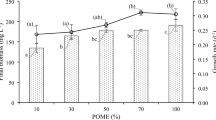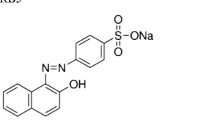Abstract
Agricultural wastewater that produces color are of environmental and health concern as colored effluent can produce toxic and carcinogenic by-products. From this study, batch culture optimization using response surface methods indicated that the fungus isolated from the pineapple solid waste, Curvularia clavata was able to decolorize sterile palm oil mill effluent (POME) which is mainly associated with polyphenol and lignin. Results showed successful decolorization of POME up to 80 % (initial ADMI [American Dye Manufacturing Index] of 3,793) with 54 % contributed by biosorption and 46 % by biodegradation after 5 days of treatment. Analysis using HPLC and GC-MS showed the degradation of color causing compound such as 3-methoxyphenyl isothiocynate and the production of new metabolites. Ecotoxicity test indicated that the decolorized effluent is safe for discharge. To determine the longevity of the fungus for a prolonged decolorization period, sequential batch decolorization studies were carried out. The results showed that lignin peroxidase and laccase were the main ligninolytic enzymes involved in the degradation of color. Carboxymethyl cellulase (CMCase) and xylanase activities were also detected suggesting possible roles of the enzymes in promoting growth of the fungus which consequently contributed to improved decolorization of POME. In conclusion, the ability of C. clavata in treating color of POME indicated that C. clavata is of potential use for decolorization and degradation of agricultural wastewater containing polyphenolic compounds.






Similar content being viewed by others
References
Agustin M, Sengpracha W, Phutdhawong W (2008) Electrocoagulation of palm oil mill effluent. Int J Environ Res Public Health 5(3):177–180
Ali MIA, Khalil NM, El-Ghany MNA (2012) Biodegradation of some polycyclic aromatic hydrocarbons by Aspergillus terreus. Afr J Microbiol Res 6(16):3783–3790
Anastasi A, Parato B, Spina F, Tigini V, Prigione V, Varese GC (2011) Decolourisation and detoxification in the fungal treatment of textile wastewaters from dyeing processes. N Biotechnol 29(1):38–45
Anastasi A, Spina F, Prigione V, Tigini V, Giansanti P, Varese GC (2010) Scale-up of a bioprocess for textile wastewater treatment using Bjerkandera adusta. Bioresour Technol 101(9):3067–3075. doi:10.1016/j.biortech.2009.12.067
Arora DS, Gill PK (2001) Comparison of two assay procedures for lignin peroxidase. Enzyme Microb Technol 28(7–8):602–605
DOE (1999) Industrial processes and the environment (Handbook no.3): crude palm oil industry. Department of Environment Malaysia, Kuala Lumpur
Ebright JR, Chandrasekar PH, Marks S, Fairfax MR, Aneziokoro A, McGinnis MR (1999) Invasive sinusitis and cerebritis due to Curvularia clavata in an immunocompetent adult. Clin Infect Dis 28(3):687–689
Ergül F, Sargın S, Öngen G, Sukan F (2010) Dephenolization and decolorization of olive mill wastewater through sequential batch and co-culture applications. World J Microbiol Biotechnol:1–8. doi:10.1007/s11274-010-0433-4
Fan Y-M, Huang W-M, Li S-F, Wu G-F, Li W, Chen R-Y (2009) Cutaneous phaeohyphomycosis of foot caused by Curvularia clavata. Mycoses 52(6):544–546. doi:10.1111/j.1439-0507.2008.01646.x
Grainger S, Fu G, Hall E (2010) Biosorption of colour-imparting substances in biologically treated pulp mill effluent using Aspergillus niger fungal biomass. Water Air Soil Pollut:1–12. doi:10.1007/s11270-010-0582-y
Grimwood BE, Ashman F, Jarman CG, Dendy DAV (1975) Coconut palm products: their processing in developing countries. Food and Agriculture Organization of the United Nations, Rome
HACH (2005) Hach water analysis DR5000 spectrohotometer procedures manual. HACH Company, USA
Iandolo D, Piscitelli A, Sannia G, Faraco V (2011) Enzyme production by solid substrate fermentation of Pleurotus ostreatus and Trametes versicolor on tomato pomace. Appl Biochem Biotechnol 163(1):40–51. doi:10.1007/s12010-010-9014-0
Jin X-C, Liu G-Q, Xu Z-H, Tao W-Y (2007) Decolorization of a dye industry effluent by Aspergillus fumigatus XC6. Appl Microbiol Biotechnol 74(1):239–243. doi:10.1007/s00253-006-0658-1
Jones TH, Md R, Pon N (1979) Cellulases released during the germination of Dictyostelium discoideum spores. J Bacteriol 137(2):752–757
Jonstrup M, Kumar N, Guieysse B, Murto M, Mattiasson B (2012) Decolorization of textile dyes by Bjerkandera sp. BOL 13 using waste biomass as carbon source. J Chem Technol Biotechnol doi:10.1002/jctb.3852
Kanwal H, Reddy M (2011) Effect of carbon, nitrogen sources and inducers on ligninolytic enzyme production by Morchella crassipes. World J Microbiol Biotechnol 27(3):687–691. doi:10.1007/s11274-010-0507-3
Karakaya A, Laleli Y, Takaç S (2012) Development of process conditions for biodegradation of raw olive mill wastewater by Rhodotorula glutinis. Int Biodeter Biodegr 75(0):75–82. doi:10.1016/j.ibiod.2012.09.005
Karim MAA, Annuar MSM (2009) Novel application of coconut husk as growth support matrix and natural inducer of fungal laccase production in a bubble column reactor. Asia-Pac J of Mol Biol Biotechnol 17(2):47–52
Kiiskinen LL, Rättö M, Kruus K (2004) Screening for novel laccase-producing microbes. J Appl Microbiol 97(3):640–646. doi:10.1111/j.1365-2672.2004.02348.x
Korabecna M (2007) The variability in the fungal ribosomal DNA (ITS1, ITS2, and 5.8 S rRNA Gene): its biological meaning and application in medical mycology. In: Communicating Current Research and Educational Topics and Trends in Applied Microbiology. Formatex, pp 783–787
Lee K-M, Yu J, Son M, Lee Y-W, Kim K-H (2011) Transmission of Fusarium boothii mycovirus via protoplast fusion causes hypovirulence in other phytopathogenic fungi. PLoS ONE 6(6):e21629. doi:10.1371/journal.pone.0021629
Miranda MP, Benito GG, Cristobal NS, Nieto CH (1996) Color elimination from molasses wastewater by Aspergillus niger. Bioresour Technol 57(3):229–235
MPOB (2012) Review of the Malaysian oil palm industry 2011. Economics and Industry Development Division, Malaysian Palm Oil Board
Neo Y-P, Ariffin A, Tan C-P, Tan Y-A (2010) Phenolic acid analysis and antioxidant activity assessment of oil palm (E. guineensis) fruit extracts. Food Chem 122(1):353–359
Neoh C, Yahya A, Adnan R, Abdul Majid Z, Ibrahim Z (2013) Optimization of decolorization of palm oil mill effluent (POME) by growing cultures of Aspergillus fumigatus using response surface methodology. Environ Sci Pollut Res 20(5):2912–2923. doi:10.1007/s11356-012-1193-5
Ortega-Clemente A, Caffarel-Méndez S, Ponce-Noyola MT, Barrera-Córtes J, Poggi-Varaldo HM (2009) Fungal post-treatment of pulp mill effluents for the removal of recalcitrant pollutants. Bioresour Technol 100(6):1885–1894
Oswal N, Sarma PM, Zinjarde SS, Pant A (2002) Palm oil mill effluent treatment by a tropical marine yeast. Bioresour Technol 85(1):35–37
Patel R, Suresh S (2008) Kinetic and equilibrium studies on the biosorption of reactive black 5 dye by Aspergillus foetidus. Bioresour Technol 99(1):51–58
Philippoussis A, Diamantopoulou P, Papadopoulou K, Lakhtar H, Roussos S, Parissopoulos G, Papanikolaou S (2011) Biomass, laccase and endoglucanase production by Lentinula edodes during solid state fermentation of reed grass, bean stalks and wheat straw residues. World J Microbiol Biotechnol 27(2):285–297. doi:10.1007/s11274-010-0458-8
Raja Ehsan Shah RSS, Kaka Singh PK (2004) Treatment of Palm Oil Mill Effluent (POME) using membrane technology. In: Regional symposium on membrane science and technology, Puteri Pan Pacific Hotel, Johor Bharu
Saavedra M, Benitez E, Cifuentes C, Nogales R (2006) Enzyme activities and chemical changes in wet olive cake after treatment with Pleurotus ostreatus or Eisenia fetida. Biodegradation 17(1):93–102. doi:10.1007/s10532-005-4216-9
Sanghi R, Dixit A, Verma P (2011) Evaluation of Coriolus versicolor for its tolerance towards toxic sulphonic azo dyes in sequential batch mode. Process Saf Environ Prot 89(1):15–21. doi:10.1016/j.psep.2010.08.007
Sulaiman N, Ling CK (2004) Membrane ultrafiltration of treated palm oil mill effluent (POME). Journal Teknologi 41:113–120
Vujčić M, Jankov RM (1990) Microbiologic transformation of progesterone by Curvularia clavata Jain. Steroids 55(1):17–21. doi:10.1016/0039-128X(90)90068-M
Xin B, Xia Y, Zhang Y, Aslam H, Liu C, Chen S (2012) A feasible method for growing fungal pellets in a column reactor inoculated with mycelium fragments and their application for dye bioaccumulation from aqueous solution. Bioresour Technol 105:100–105
Yadav S, Chandra R (2012) Biodegradation of organic compounds of molasses melanoidin (MM) from biomethanated distillery spent wash (BMDS) during the decolourisation by a potential bacterial consortium. Biodegradation:1–12. doi:10.1007/s10532-012-9537-x
Yang X, Wang J, Zhao X, Wang Q, Xue R (2011a) Increasing manganese peroxidase production and biodecolorization of triphenylmethane dyes by novel fungal consortium. Bioresour Technol 102(22):10535–10541
Yang Y, Zhou J, Lu H, Yuan Y, Zhao L (2011b) Isolation and characterization of a fungus Aspergillus sp. strain F-3 capable of degrading alkali lignin. Biodegradation 22(5):1017–1027. doi:10.1007/s10532-011-9460-6
Zahrim AY, Rachel FM, Menaka S, Su SY, Melvin F, Chan ES (2009) Decolorisation of anaerobic palm oil mill effluent via activated sludge-granular activated carbon. World Applied Sciences Journal 5 (Special Issue for Environment):126–129
Acknowledgements
The authors express their appreciation to the Ministry of Sciences and Innovation Malaysia (National Science Fellowship) and Universiti Teknologi Malaysia for providing financial support to conduct the studies reported in this article.
Author information
Authors and Affiliations
Corresponding author
Additional information
Responsible editor: Gerald Thouand
Rights and permissions
About this article
Cite this article
Neoh, C.H., Lam, C.Y., Lim, C.K. et al. Decolorization of palm oil mill effluent using growing cultures of Curvularia clavata . Environ Sci Pollut Res 21, 4397–4408 (2014). https://doi.org/10.1007/s11356-013-2350-1
Received:
Accepted:
Published:
Issue Date:
DOI: https://doi.org/10.1007/s11356-013-2350-1




